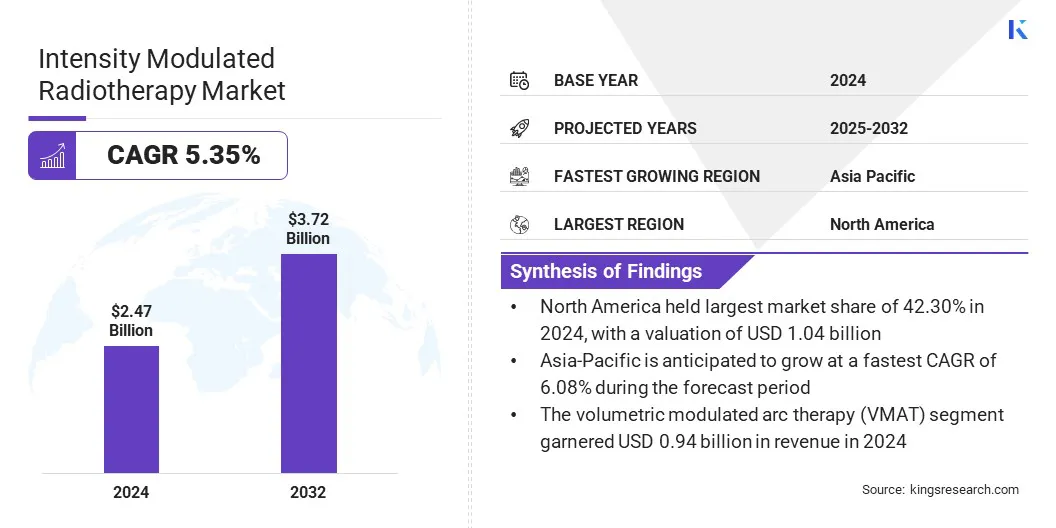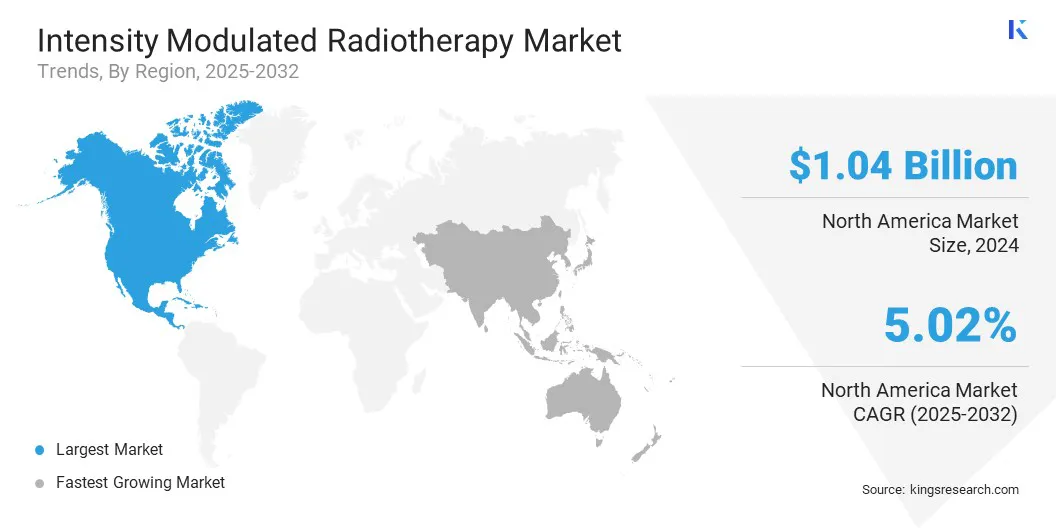enquireNow
Intensity Modulated Radiotherapy Market
Intensity Modulated Radiotherapy Market Size, Share, Growth & Industry Analysis, By Technology Type (Step-and-Shoot IMRT, Dynamic Multileaf Collimator (DMLC) IMRT, Volumetric Modulated Arc Therapy (VMAT), Tomotherapy), By Application (Prostate Cancer, Lung Cancer, Breast Cancer), By End User, and Regional Analysis, 2025-2032
pages: 180 | baseYear: 2024 | release: August 2025 | author: Versha V.
Market Definition
Intensity modulated radiotherapy (IMRT) is a sophisticated radiation therapy technique designed to deliver highly targeted doses to cancerous tumors while reducing radiation exposure to nearby healthy tissues.
It uses computer-controlled linear accelerators to modulate the intensity of radiation beams in multiple small volumes. This technique is commonly used in the treatment of cancers in the head and neck, prostate, breast, and central nervous system.
Intensity Modulated Radiotherapy Market Overview
The global intensity modulated radiotherapy market size was valued at USD 2.47 billion in 2024 and is projected to grow from USD 2.59 billion in 2025 to USD 3.72 billion by 2032, exhibiting a CAGR of 5.35% during the forecast period. This growth is attributed to the rising adoption of intensity modulated radiotherapy across leading oncology centers and hospitals focused on precision cancer treatment.
Increasing demand for highly targeted radiation delivery, reduced toxicity, and improved patient outcomes is fueling the use of this technique in prostate, head and neck, breast, and brain cancers.
Key Highlights
- The intensity modulated radiotherapy industry size was valued at USD 2.47 billion in 2024.
- The market is projected to grow at a CAGR of 5.35% from 2025 to 2032.
- North America held a market share of 42.30% in 2024, valued at USD 1.04 billion.
- The volumetric modulated arc therapy (VMAT) segment garnered USD 0.94 billion in revenue in 2024.
- The lung cancer segment is expected to reach USD 0.96 billion by 2032.
- The independent radiotherapy centers segment is anticipated to witness the fastest CAGR of 6.31% during the forecast period.
- Asia Pacific is anticipated to grow at a CAGR of 6.08% through the projection period.
Major companies operating in the intensity modulated radiotherapy market are Elekta, Accuray Incorporated, Siemens Healthineers AG, Mevion Medical Systems, RefleXion, Hitachi, Ltd., IBA Worldwide, Shinva Medical Instrument Co., Ltd., Panacea Medical Technologies Pvt. Ltd., and MITSUBISHI HEAVY INDUSTRIES, LTD.

The growing emphasis on personalized treatment planning, tissue-sparing protocols, and quality-of-life improvement is supporting market expansion. Additionally, advancements in imaging-guided radiotherapy, automation in treatment planning, and rising investments in radiotherapy infrastructure across emerging economies are accelerating market growth.
Market Driver
Rising Global Cancer Incidence
The growth of the intensity modulated radiotherapy market is driven by the rising global cancer burden and the increasing need for highly precise, tissue-sparing treatment approaches. According to the World Health Organization (WHO), global cancer incidence is projected to rise by 87.5% by 2050. Among males, oral, lung, prostate, and digestive tract cancers are projected to be the most prevalent, while breast, cervical, and uterine cancers are anticipated to be the most common among females.
The prevalence of complex tumor types in the head, neck, prostate, and central nervous system is boosting demand for radiotherapy solutions that deliver high-dose accuracy while protecting surrounding healthy tissue. Healthcare providers are adopting intensity modulated radiotherapy to improve clinical outcomes, reduce treatment-related toxicity, and support better quality of life for patients.
This transition is further enabled by advancements in imaging systems, treatment planning software, and linear accelerator technologies that support personalized and adaptive therapy. The emphasis on evidence-based, targeted cancer care is prompting hospitals and oncology centers to upgrade their radiotherapy infrastructure, thereby driving sustained market expansion.
Market Challenge
High Capital and Operational Costs
High capital and operational expenditure pose a significant challenge to the growth of the intensity modulated radiotherapy market, particularly in resource-constrained healthcare settings. The cost of acquiring advanced linear accelerators, treatment planning systems, and quality assurance tools, combined with the need for skilled personnel and facility upgrades, creates a substantial financial barrier for many institutions.
These high costs contribute to delayed procurement, limited accessibility, and underutilization in low- and middle-income regions. As a result, the adoption of intensity-modulated radiotherapy remains limited, as high implementation costs continue to outweigh its clinical benefits for institutions.
To overcome these obstacles, market players are adopting cost-reduction strategies such as equipment leasing, centralized planning services, and modular system integration. Government support, international funding, and public-private partnerships are aiding infrastructure development and expanding access.
Training initiatives led by equipment manufacturers, healthcare institutions, professional associations, and government health agencies often in collaboration with international organizations are enhancing the skills of oncologists, physicists, and radiation therapists. Additionally, technology-sharing agreements are strengthening local capacity, enabling broader adoption of IMRT solutions worldwide.
Market Trend
Growing Adoption of Adaptive Radiotherapy Protocols
The growing adoption of adaptive radiotherapy protocols is transforming the intensity modulated radiotherapy market by enabling treatment plans to be modified in real time based on changes in tumor size, shape, or patient anatomy.
Advances in imaging technologies, real-time monitoring, and treatment planning software are allowing clinicians to deliver radiation with greater precision while minimizing exposure to healthy tissues. These improvements are enhancing treatment effectiveness across various cancer types.
The integration of adaptive protocols supports personalized therapy by accommodating anatomical variations throughout the treatment course, leading to better patient outcomes.
Additionally, advancements in automation and workflow optimization are reducing planning time and clinical workload. These developments are improving the efficiency and precision of radiotherapy, strengthening the role of adaptive radiotherapy in enhancing treatment accuracy and clinical effectiveness in oncology.
Intensity Modulated Radiotherapy Market Report Snapshot
|
Segmentation |
Details |
|
By Technology Type |
Step-and-Shoot IMRT, Dynamic Multileaf Collimator (DMLC) IMRT, Volumetric Modulated Arc Therapy (VMAT), and Tomotherapy |
|
By Application |
Prostate Cancer, Lung Cancer, Breast Cancer, Brain Cancer, Gynecological Cancers, Gastrointestinal Cancer, and Other Cancers |
|
By End User |
Hospitals, Independent Radiotherapy Centers, and Others |
|
By Region |
North America: U.S., Canada, Mexico |
|
Europe: France, UK, Spain, Germany, Italy, Russia, Rest of Europe | |
|
Asia-Pacific: China, Japan, India, Australia, ASEAN, South Korea, Rest of Asia-Pacific | |
|
Middle East & Africa: Turkey, U.A.E., Saudi Arabia, South Africa, Rest of Middle East & Africa | |
|
South America: Brazil, Argentina, Rest of South America |
Market Segmentation
- By Technology Type (Step-and-Shoot IMRT, Dynamic Multileaf Collimator (DMLC) IMRT, Volumetric Modulated Arc Therapy (VMAT), and Tomotherapy): The volumetric modulated arc therapy (VMAT) segment earned USD 0.94 billion in 2024 due to its faster treatment delivery, improved dose accuracy, and growing clinical adoption.
- By Application (Prostate Cancer, Lung Cancer, Breast Cancer, Brain Cancer, Gynecological Cancers, Gastrointestinal Cancer, and Other Cancers): The lung cancer segment held 23.70% of the market in 2024, due to the high incidence of lung cancer globally and the effectiveness of intensity modulated radiotherapy in targeting tumors while sparing healthy lung tissue.
- By End User (Hospitals, Independent Radiotherapy Centers, and Others): The hospitals segment is projected to reach USD 1.27 billion by 2032, owing to the increasing number of cancer patients treated in hospital settings and the availability of advanced radiotherapy infrastructure.
Intensity Modulated Radiotherapy Market Regional Analysis
Based on region, the market has been classified into North America, Europe, Asia Pacific, Middle East & Africa, and South America.

North America intensity modulated radiotherapy market share stood at 42.30% in 2024, valued at USD 1.04 billion. This dominance is attributed to the region’s well-developed healthcare infrastructure, high adoption of advanced radiotherapy technologies, and the presence of leading medical device manufacturers specializing in intensity modulated radiotherapy systems.
Furthermore, strong government support for cancer treatment programs through substantial investments in research and development, and favorable reimbursement policies to drive the adoption of these therapies across North America.
Asia-Pacific is poised for a CAGR of 6.08% over the forecast period. This growth is propelled by the rising cancer prevalence, expanding healthcare infrastructure, and increasing adoption of advanced radiotherapy techniques across Asia-Pacific. The region’s focus on improving cancer care delivery through national health initiatives and public–private partnerships is driving demand for intensity modulated radiotherapy systems.
Investments by government health ministries, private healthcare providers, and international funding agencies in oncology centers, medical training, and radiotherapy equipment are further supporting the transition toward precision-based treatment approaches. Moreover, growing awareness of early cancer diagnosis and improved access to radiotherapy services in emerging economies are accelerating market expansion across the region.
Regulatory Frameworks
- In the United States, 21 CFR Part 892 regulates radiology devices, including linear accelerators and IMRT systems. It classifies these devices as Class II or Class III medical devices, requiring premarket clearance through 510(k) or approval via the PMA pathway.
- In Canada, IMRT systems are regulated as Class III devices under the Medical Devices Regulations (SOR/98-282). Manufacturers must obtain a Medical Device Licence, supported by evidence of safety, efficacy, and quality assurance systems.
Competitive Landscape
Companies operating in the intensity modulated radiotherapy industry are actively strengthening their market position through technological innovation, product diversification, and strategic collaborations with healthcare providers and research institutions.
Key players are investing in research and development to enhance treatment precision, automate planning workflows, and integrate advanced imaging and artificial intelligence into radiotherapy systems to improve clinical outcomes and operational efficiency.
They are also focusing on expanding their portfolios with compact, high-performance linear accelerators and adaptive radiotherapy solutions to meet the growing demand for personalized cancer care.
Additionally, firms are engaging in partnerships with hospitals, government health programs, and cancer care networks to secure procurement contracts, expand global reach, and accelerate adoption across both developed and emerging healthcare sectors..
Key Companies in Intensity Modulated Radiotherapy Market:
- Elekta
- Accuray Incorporated
- Siemens Healthineers AG
- Mevion Medical Systems
- RefleXion
- Hitachi, Ltd.
- IBA Worldwide
- Shinva Medical Instrument Co., Ltd.
- Panacea Medical Technologies Pvt. Ltd.
- MITSUBISHI HEAVY INDUSTRIES, LTD.
Recent Developments (Partnerships)
- In August 2025, Amethyst Radiotherapy Austria and IASO-Health GmbH partnered to expand cross-border access to precision cancer treatments, including advanced Intensity Modulated Radiotherapy (IMRT). The collaboration gives IASO-Health patients priority access to Amethyst’s Vienna center, equipped with Elekta Versa HD technology and state-of-the-art imaging systems.
freqAskQues
